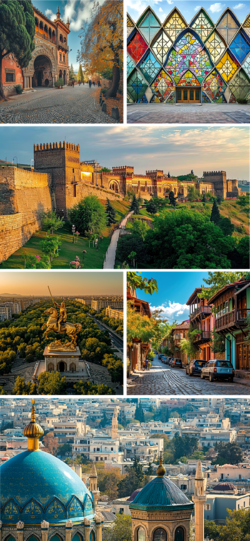Damazar
Damazar
. DAMAZAR. | |
|---|---|
Metropolis | |
 Clockwise from top: Entrance to the King's palace complex, National Museum of Glass, View of the Tamasik Fort, old traditional street, Cityscape of the city with the All-Martyrs Gharam in front, statue of Qak Taraşbaş. | |
| Nickname(s): Tamisang The Holiest City of Iron Citadel of the 3 Kings | |
| Union | |
| Constituent Country | |
| Earliest settlement | c. 1000 BCE |
| Government | |
| • Mayor | Beşi Hatanli |
| Area | |
| • Total | 2,800.61 km2 (1,081.32 sq mi) |
| Population (2016 census) | |
| • Total | 8,723,132 |
| • Density | 4,850.36/km2 (12,562.4/sq mi) |
| Demonym(s) | Damazari |
| Time zone | SCT+3 |
Damazar (Koman: Damazar), historically known as Domajar or Tamisang is the largest city in Tamiran and one of the historical capitals of the Great Horde. It currently serves as the capital of Torosha and remains the most populated city in central Vaniua. It is located in the ? and is part of the Damazar Autonomous Region with a population of 8.7 million people. The city has served as the capital of several empires, most prominently as the capital of the Tameng Hojanate, later on becoming one of the capitals of the Great Horde, with its final stage as the capital of the Torosh Khanate from 1732 to 1773, earning the nickname City of the 3 Kings. Damazar is currently the seat of the Damazar Autonomous Region and enjoys considerably higher autonomy than other Torosh provincial seats.
Damazar is highly renowned for its landmarks, mainly attributed to its rich history, harbouring various cultural periods and presenting a cosmopolitan scene worthy of its past. The city first came into prominence as the seat of the Kaatian Hojas, serving as the capital of the Tameng Hojanate in 548 CE, a period in which the Great Gharam of All-Martyrs was built. The city became one of the first religious centres for Zarasaism, under the supervision of one of the First Enlighteners Kamas "The Noble", seeing the gradual conversion of many neighbouring states.
Many of Damazar's historical sites are attributed to its period as the capital of the Great Horde between 1315 CE to 1380 CE, showcasing palaces, monuments and ruins. During this time, an early style of a more ornate form of Asharid architecture developed, which would later become a seeding ground for the Shozasan-based Huzara architectural movement. Later on, during the apogee of the Torosh Khanate, many monuments emphasising the rising Torosh Qaks were built, and some medieval quarters were torn down to make way for more contemporary styles, mostly derivations of classical Asharid architecture as well as 1800s styles from the architectural movement of Shanvan, popularly known as 'Damazari'.